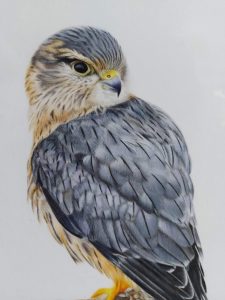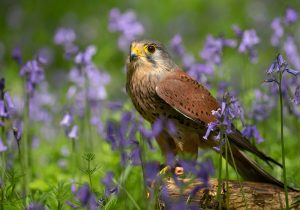This week’s blog follows on from the Wildlife Wednesday posts and Fun Fact Friday on our social media which were all about Hobbies and the other falcons we have here in the UK, so here are a few more amazing insights into these amazing Birds of Prey.
 Let’s start with the stunning Hobby. These guys are definitely the standout dressers of the falcon world with their dark striped waist coats, red buff trousers and dark grey over coat with a dark malar stripe on a white face really standing out as a lovely mask.
Let’s start with the stunning Hobby. These guys are definitely the standout dressers of the falcon world with their dark striped waist coats, red buff trousers and dark grey over coat with a dark malar stripe on a white face really standing out as a lovely mask.
Arriving here in the UK from April to May, they use the UK as a base for breeding, staying here for the whole of the summer. Feasting on insects usually over bodies of water, mayflies, dragonflies etc, catching them in flight and eating them on the wing, along with small birds over open grasslands.
Like most falcons they don’t build a fabulous nest, instead simply robbing a magpies or crows nest, producing 2-3 eggs per year. The males and female are similar in colouration however, like all birds of prey the girls are larger than the boys. Once the chicks are successfully reared it’s back to Africa where they overwinter in the warmer weather.
They are currently a green listed bird meaning their numbers are of least concern with the population spreading north over the past few decades finding their way to the North of England but still rare in Scotland.
 Peregrine – Well this one could fill many, many pages so I’ll keep it to the highlights, which obviously has to start with its speed. You don’t win the fasted animal on the planet award for nothing, 242MPH was achieved by a falcon called ‘Frightful’ in 1999 in the USA in a flight experiment. You can read all about it here https://www.guinnessworldrecords.com/world-records/70929-fastest-bird-diving
Peregrine – Well this one could fill many, many pages so I’ll keep it to the highlights, which obviously has to start with its speed. You don’t win the fasted animal on the planet award for nothing, 242MPH was achieved by a falcon called ‘Frightful’ in 1999 in the USA in a flight experiment. You can read all about it here https://www.guinnessworldrecords.com/world-records/70929-fastest-bird-diving
However, even though it was an experiment it can’t take away from the fact that even in a regular Thursday night stoop for a simple pigeon dinner the Peregrine is a lethal predator. Once of our favourite things to talk about during our handling sessions with our Peregrine, Maverick, is the adaptation to urban life. Utilising buildings, our huge pigeon numbers and even the street lighting to allow for 24-hour hunting. In the UK the Peregrine falcon has fought its way back from the devastating impact of DDT to now boast almost 20% of the European population, a number we should be proud of and protect.
 Merlins – no not a magical interlude (although who doesn’t love those) but the UK’s smallest falcon and a hard one to spot, not only due to their small stature and high speed flight but the fact they are a red listed species. Read here to find out more about the RSPB’s red list https://www.rspb.org.uk/birds-and-wildlife/wildlife-guides/uk-conservation-status-explained/
Merlins – no not a magical interlude (although who doesn’t love those) but the UK’s smallest falcon and a hard one to spot, not only due to their small stature and high speed flight but the fact they are a red listed species. Read here to find out more about the RSPB’s red list https://www.rspb.org.uk/birds-and-wildlife/wildlife-guides/uk-conservation-status-explained/
They are a permanent resident in northern England however, numbers are boosted in winter with those moving down from Iceland to overwinter in our slightly warmer climate.
The Merlin is a dimorphic species meaning the boys and girls look different with the females being cream and brown and the males being grey with orange/cream chest and tummies. About the size of a large blackbird these highspeed predators catch birds on the wing such as pipets and sparrows, supplementing with insects when needed.
 Finally, and by no means least, the Kestrel – an outstanding falcon with the wind beneath their wings hovering like a pro, keeping their head perfectly still whilst their tail acts to balance and their wings rotate in small circles. This amazing flight technique used by other birds of prey but mastered by the Kestrel helps us identify it as we are zooming down the motorway or going past on a train, with the unmanaged grasslands banking the roads and railway lines being a preferred place to hunt their small mammals. Their diet is wide and wonderful with small mammals such as voles, mice and shrews making up the bulk of their diet but insects, reptiles and birds supplementing too. The boys stand out with a marvellous blue/grey head and tail with the girls being brown and larger, both often seen perching on wires and telegraph poles waiting for the moment to pounce. Once common, the Kestrel has taken a worrying downturn in population, dropping almost 40% since 1995 with no clear reason why. Perhaps lack of nest sites, lack of insects or habitat loss are to blame but it is a worrying trend and hopefully one that won’t continue.
Finally, and by no means least, the Kestrel – an outstanding falcon with the wind beneath their wings hovering like a pro, keeping their head perfectly still whilst their tail acts to balance and their wings rotate in small circles. This amazing flight technique used by other birds of prey but mastered by the Kestrel helps us identify it as we are zooming down the motorway or going past on a train, with the unmanaged grasslands banking the roads and railway lines being a preferred place to hunt their small mammals. Their diet is wide and wonderful with small mammals such as voles, mice and shrews making up the bulk of their diet but insects, reptiles and birds supplementing too. The boys stand out with a marvellous blue/grey head and tail with the girls being brown and larger, both often seen perching on wires and telegraph poles waiting for the moment to pounce. Once common, the Kestrel has taken a worrying downturn in population, dropping almost 40% since 1995 with no clear reason why. Perhaps lack of nest sites, lack of insects or habitat loss are to blame but it is a worrying trend and hopefully one that won’t continue.
Thank you for reading and dont forget if you would like to learn more about our beautiful birds do come along on our Half Day Experience Sessions, Family Falconry sessions, or book us for an educational talk.
References
BTO website – www.bto.org
RSPB Website – https://www.rspb.org.uk
Ruth Weaver for picture
https://www.ruths-portraits.com
Jacob ONeil for photo of Hobby.
